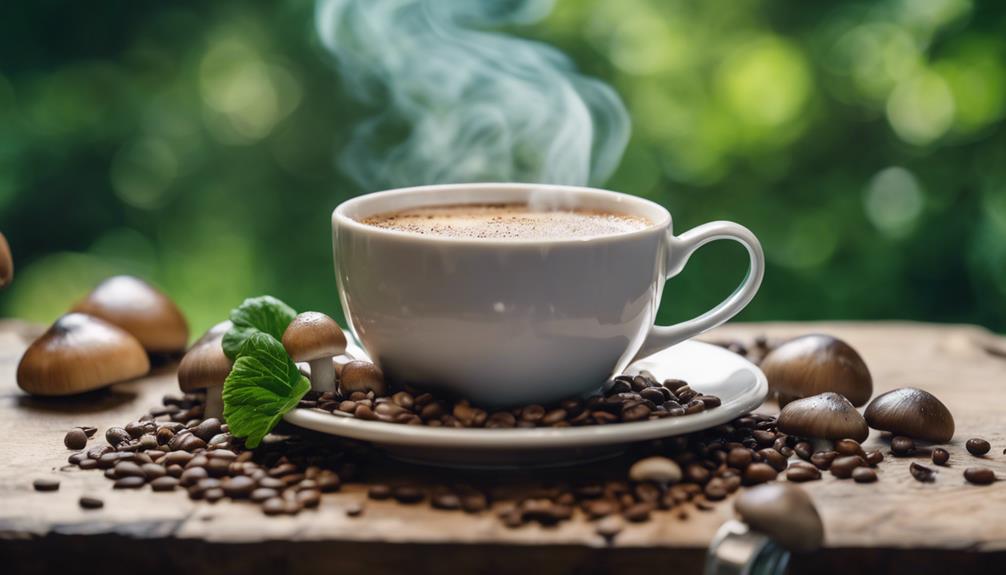The Hugo Spritz is a delightful cocktail that's perfect for warm weather or festive gatherings. You combine 3 oz of prosecco, 1 oz of elderflower syrup, and a splash of soda water, then garnish with fresh mint and a lime wedge. This drink offers a refreshing balance of sweetness and carbonation, making it a lighter alternative to other spritz variations. With its vibrant presentation, it's sure to impress your guests and spark conversation. Plus, it's easy to make multiple servings for gatherings. Stick around, and you'll discover even more tips and tricks for crafting the perfect Hugo Spritz!
Key Takeaways
- Hugo Spritz originated in Northern Italy, combining prosecco, elderflower syrup, soda water, and fresh mint for a refreshing cocktail.
- It gained popularity in the early 2000s as a lighter alternative to traditional bitter Spritz variations.
- The drink is visually appealing, often garnished with mint leaves or lime slices, making it perfect for gatherings.
- Easy to prepare in large batches, Hugo Spritz is ideal for summer events and social occasions.
- Its balanced flavor profile offers a sweet, effervescent experience, customizable based on personal taste preferences.
History

The rich history of the Hugo Spritz reflects both innovation and tradition in the world of cocktails. You might be surprised to learn that this refreshing drink originated in Northern Italy, specifically the Trentino-Alto Adige region. It gained popularity in the early 2000s, capturing the hearts of locals and travelers alike.
The cocktail emerged as a lighter alternative to the more bitter Spritz variations, emphasizing a delightful balance of flavors.
As you sip on a Hugo Spritz, you're savoring a blend of prosecco, elderflower syrup, sparkling water, and fresh mint. This combination highlights the Italian penchant for using locally sourced ingredients, showcasing a commitment to freshness and quality.
The drink's rise can be attributed to social media and its vibrant presentation, making it a favorite for summer gatherings and aperitivo moments.
Over the years, the Hugo Spritz has evolved, maintaining its essence while adapting to various tastes and preferences. You'll find it on menus across the globe, symbolizing the trend of lighter, herb-infused cocktails.
Its journey from a regional favorite to an international sensation illustrates how traditions can innovate, inviting you to enjoy a taste of Italy, no matter where you are.
Recipe

The Hugo Spritz is a refreshing Italian cocktail that perfectly blends the herbal notes of elderflower syrup with the crispness of Prosecco and a splash of soda water.
It's an ideal drink for summer afternoons or festive gatherings, offering a delightful balance of sweetness and effervescence. The addition of mint and lime gives it a vibrant twist, making it not just a beverage but a refreshing experience.
To prepare the Hugo Spritz, you'll want to gather your ingredients and have a few simple tools on hand, such as a jigger for measuring, a stirring spoon, and a glass to serve it in.
This cocktail is incredibly easy to make, allowing you to whip up multiple servings in no time. Once you have everything ready, you can impress your guests with this elegant drink that's sure to become a favorite.
Ingredients:
- 3 oz Prosecco
- 1 oz elderflower syrup
- 1 oz soda water
- Fresh mint leaves
- 1 lime wedge
- Ice cubes
Instructions:
In a large wine glass filled with ice cubes, pour in the Prosecco, elderflower syrup, and soda water.
Gently stir the mixture to combine the flavors. Squeeze the lime wedge into the drink, then drop it in for added zest.
Finally, add a few fresh mint leaves and stir lightly to release their aroma before serving.
Extra Tips:
For an extra touch of elegance, consider garnishing your Hugo Spritz with additional mint leaves or even a slice of cucumber.
You can adjust the sweetness by varying the amount of elderflower syrup according to your taste.
If you want to make a larger batch for a party, simply scale up the ingredients while maintaining the same proportions, and serve it in a pitcher for easy self-service.
Enjoy your refreshing cocktail!
Cooking Steps

To make the perfect Hugo Spritz, you'll want to start by chilling your glass with ice.
Next, add the Aperol and Prosecco, then garnish with fresh mint.
Step 1. Chill Glass With Ice

Chilling your glass with ice is a simple yet effective way to enhance your Hugo Spritz experience.
Start by selecting your favorite glass, whether it's a wine glass or a large tumbler. Next, grab some ice cubes from your freezer. Fill your glass about halfway with ice, making sure not to overfill it. This will help keep your drink cold without diluting it too quickly.
Let the ice sit for a few minutes, allowing the glass to chill thoroughly. You can even swirl the ice gently to speed up the cooling process. As the glass chills, you're setting the stage for a refreshing drink.
Once you feel your glass has cooled enough, carefully discard the ice. You can do this by tipping the glass over the sink or a bowl, ensuring all the ice is removed.
Now, your glass is perfectly prepped to hold your Hugo Spritz ingredients. A chilled glass not only keeps your drink at the ideal temperature but also enhances the overall presentation.
You'll notice the difference in your drink's taste and enjoyment when you take that first sip. Cheers to a refreshing start!
Step 2. Add Aperol and Prosecco

With your glass now chilled and ready, it's time to layer in the key ingredients that make a Hugo Spritz so delightful.
Start by pouring in a generous shot of Aperol—about 2 ounces. It's the vibrant orange liqueur that gives your drink a slightly bitter yet refreshing kick. Pour it gently over the ice to keep everything chilled.
Next, grab your bottle of Prosecco. You'll want to add about 3 ounces of this sparkling wine, which adds a bubbly effervescence that elevates the entire drink. Pour it slowly over the Aperol, allowing the two to mix naturally without creating too much foam.
As you watch the colors swirl together, you'll notice the beautiful orange hue complemented by the golden bubbles.
Don't be afraid to adjust the ratios slightly based on your taste preferences; some enjoy a more pronounced Aperol flavor, while others prefer the sweetness of the Prosecco. Just remember, balance is key!
Once you've combined these two delicious ingredients, your Hugo Spritz is almost complete.
Take a moment to admire your creation before moving on to the final touch.
Step 3. Garnish With Fresh Mint

Fresh mint leaves add a burst of aroma and a touch of elegance to your Hugo Spritz. To incorporate this refreshing ingredient, start by selecting fresh, vibrant mint leaves. Look for leaves that are bright green and free from any wilting or browning.
Once you've got your mint, gently rinse the leaves under cold water to remove any dirt or residue. Pat them dry with a clean towel.
Next, take a few leaves—about three to five should do the trick—and place them in your glass. You can either leave them whole or give them a gentle slap between your hands to release more of their aromatic oils. If you prefer a stronger mint flavor, feel free to muddle them lightly in the glass before adding your other ingredients.
As you finish assembling your Hugo Spritz, position the mint leaves so they're visible above the ice. This not only enhances the drink's visual appeal but also releases a lovely scent as you sip.
The fresh mint will elevate your cocktail experience, making each sip refreshing and fragrant. Enjoy your beautifully garnished Hugo Spritz!
Step 4. Stir Gently to Combine

After you've garnished your Hugo Spritz with fresh mint, it's time to mix the ingredients together.
Start by grabbing a long spoon or a stirrer. You'll want to gently stir the mixture to ensure all the flavors meld nicely without losing the fizz.
First, dip your spoon into the glass, reaching all the way to the bottom where the syrup and other ingredients settle. Slowly lift the spoon and then push it back down.
Repeat this motion, making sure not to agitate the drink too much. The goal is to combine the elderflower syrup, wine, and mint without causing too many bubbles to rise and spill over the rim.
Take your time with this step; a gentle stir will help to integrate the flavors while keeping the drink refreshing and vibrant.
You might notice the mint leaves start to release their aromatic essence as you stir, enhancing the overall scent and taste.
Once you feel satisfied with the blending, take a moment to admire your creation. The beautiful layers of color and the aromatic mint will have you eager to take that first sip.
Enjoy the process!
Step 5. Add a Splash of Soda

Now that you've gently combined the flavors of your Hugo Spritz, it's time to add a splash of soda.
Grab your favorite soda water or tonic—both work beautifully. Pour about two ounces into your glass, letting the bubbles dance through the mixture. This step not only adds effervescence but also balances the sweetness of the elderflower liqueur and the bitterness of the Prosecco.
As you pour, give the drink a gentle stir with a spoon or a straw. You want to incorporate the soda without losing that refreshing fizz. The goal here is to enhance the drink's lightness while keeping the vibrant flavors intact.
Once you've added the soda, take a moment to taste your creation. Adjust the soda to your liking; if you prefer a lighter drink, feel free to add more. Remember, the key to a great Hugo Spritz is finding that perfect balance between sweetness and carbonation.
Garnish your drink with a fresh sprig of mint and a slice of lime for that final touch.
Now you're ready to sip and enjoy your delightful Hugo Spritz! Cheers!
Final Thoughts

As you reflect on the delightful experience of enjoying a Hugo Spritz, it's clear that this refreshing cocktail has the potential to elevate any gathering. Its bright flavors, combining elderflower cordial, Prosecco, and fresh herbs, create a drink that's not only pleasing to the palate but also visually appealing.
You'll find that the simplicity of the ingredients allows for easy customization, making it a versatile choice for any occasion.
When you craft a Hugo Spritz, you're not just mixing a drink; you're creating a moment. Whether it's a sunny afternoon on the patio or a festive evening with friends, this cocktail invites conversation and connection. It encourages you to savor the experience, taking time to appreciate the little things.
As you consider hosting your next event, think about incorporating this delightful beverage into the mix. It's an effortless way to impress your guests while keeping the atmosphere light and enjoyable.
Frequently Asked Questions
What Is the Origin of the Name "Hugo Spritz"?
The name "Hugo" has Germanic origins, meaning "mind" or "intellect," while "Spritz" comes from the German word for "splash." Together, they evoke a lively, refreshing essence, perfect for a vibrant drink.
Can I Use Non-Alcoholic Alternatives in a Hugo Spritz?
Absolutely, you can use non-alcoholic alternatives! Try a non-alcoholic sparkling wine, elderflower syrup, and soda water. Mix them together for a refreshing drink that captures the essence of the original without the alcohol.
What Type of Glass Is Best for Serving a Hugo Spritz?
You'll want to serve your drink in a large wine glass or a stemmed glass. This shape enhances the presentation and allows for adequate space to appreciate the aromas and flavors in your refreshing beverage.
How Can I Make a Large Batch of Hugo Spritz for a Party?
To make a large batch for a party, mix equal parts prosecco and elderflower syrup in a pitcher. Add soda water, fresh mint, and lime slices. Serve over ice, and enjoy your refreshing drink with guests!
What Are Some Popular Food Pairings With a Hugo Spritz?
When enjoying a refreshing spritz, consider pairing it with light appetizers. Think bruschetta, seafood tapas, or fresh salads. These flavors complement your drink's herbal notes, enhancing the overall experience for you and your guests.









